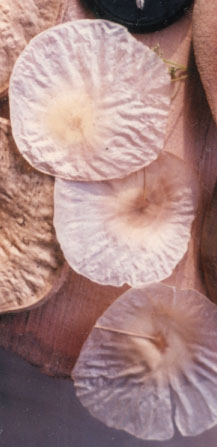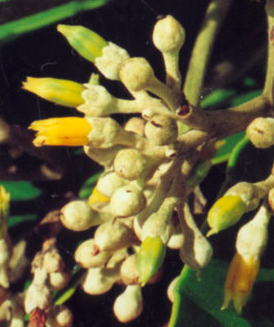Aspidosperma spruceanum Benth. ex Mull. Arg.
Apocynaceae AMARGO
Tree: Common sub-canopy evergreen tree (20-30 m) found in very humid tropical forest habitats but preferring dryer, well drained sites like those found along ridges and the sandy coastal zone. Amargo is an interesting tree for its unique anatomical features – especially the intricate and highly specialized pods and seeds that are visible in the crowns during much of the year.
Description: Amargo has a cylindrical trunk that is usually straight and columnar and that rarely exceeds 50 cm in diameter. The species sports relatively few branches and they are found clustered somewhat erratically and asymmetrically along the top fifth of the tree. These branches are long, often angular and leggy, and extremely flexible. Together with the relatively thin leaf cover, they produce a crown that is airy and open. Amargo bark is mostly smooth and gray-white in color. The tree’s leaves (20 cm by 4 cm), clustered at branch ends, are simple and alternately arranged. Thick and leathery, they are narrowly elliptical in shape, with rounded or acute apices and long petioles (2.5 cm). The blades are bright green and glossy; bearing marked parallel (not net-like) secondary venation. Leaf margins and primary veins are characteristically yellow. A light gray, fine, velvety pubescence covers Amargo twigs, flower calyxes, and leaf undersurfaces – giving these structures an unusual, whitish cast. New leaf growth occurs in May and June and adds to the foliage already present – the tree is never completely bare.
Flowers are produced in large, densely-packed terminal panicles that slightly resemble heads of broccoli. Each flower (1 cm by 0.3 cm) has a narrow tubular corolla composed of five narrow, yellow petals (fused at their bases) that is set in a five-pointed, cup-shaped calyx. Five minute stamens are attached to the inside of the corolla and the short pistil remains hidden in the flowers center. Blossoms emit a strong, sweet fragrance that is often notable from the ground. Amargo’s flowering period is an annual event of long duration, with most trees blossoming between late June and mid September. (In 1991, a secondary – but profuse and widespread – flowering was observed in December). Fruits set within a couple of months of flowering and reach full size (15 cm long by 9 cm wide) by January. Each is a flat, disk-shaped capsule composed of two dehiscent valves. Tan or creme colored, the capsule’s exterior is made soft and velveteen by the presence of a trichomic layer, while its inner surface is very rough and wrinkled – probably to keep the papery seeds from adhering to it. In mid-June – almost exactly a year after flowering began – the pods begin to open: splitting longitudinally and with each valve bending a full ninety degrees away from its initial position. About twenty, tissue-thin, disk-shaped samaras (8 cm in diameter) then begin to peal off the inner surface of the pod, dislodged by wind gusts. Each flat seed (3 cm) is surrounded by a translucent circular wing, giving the whole structure an unusual but easily recognizable appearance. (Their shape is so unusual that new visitors to Costa Rica have been known to mistake them for some sort of preconceived exotic tropical arthropod when encountered unexpectedly in the forest!) Fruiting continues from June through August. (In 1992, after the December ’91 flowering, fruits were observed from July through November). Crop size is extremely variable between seasons, and Amargo crowns range from being packed with these heavy pods to bearing only one or two.
Similar Species: Licania platypus and to a lesser extent the Virolas and Guatterias have foliage that is similar to that of Aspidosperma. Look to Amargo’s wiry, mostly bare branches and long-petioled leaves for distinguishing characteristics. Also, Amargo’s unique pods persist in the crowns for nearly a full year after flowering, and they clearly separate this tree from all other species when they are present.
Natural History: Pollination is carried out primarily through insect action, and bees are especially frequent of Amargo flowers. Seed dispersal is accomplished entirely by wind, with seeds usually being transported only a few tens of meters away from the parent tree. Germination occurs within a couple of weeks after the samara comes into contact with the warm and moist, early rainy season soil. The flat seed cotyledons turn green and a root and a shoot emerge from between them as the wing decays on damp forest floor. This tree is frequently found along the coast and its flexible, elastic limbs and thin crown probably help it to withstand the powerful gales that periodically blow in from the Pacific ocean.
Uses: Aspidosperma spruceanum wood is not widely used. However, another Aspidosperma species – also known as Amargo and found in the Osa Peninsula – is highly prized for its dense, red wood. This latter species is an archetype of beautifully formed timber trees: its perfectly straight, cylindrical, and enormously tall bole reaching unbranched heights of 40 m or more! Similar anatomically to A. spruceanum, it can be distinguished by its large size and white (not yellow) flowers.
Distribution: Amargo grows well in all very-humid tropical forest habitats with well-drained soils. A frequent component of Costa Rica’s southernwestern coastal forests, the tree is also common in the Golfo Dulce region. The species is also known from Belize, Panama, Colombia, Bolivia, Peru and Brazil.
Photos: Tree Trunk Leaf Flower Fruit Fruit2 Fruit3 Germinating Seed Wood




